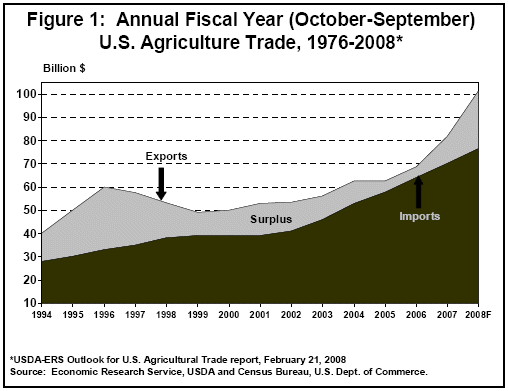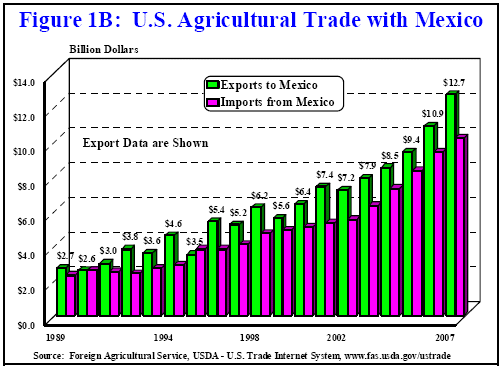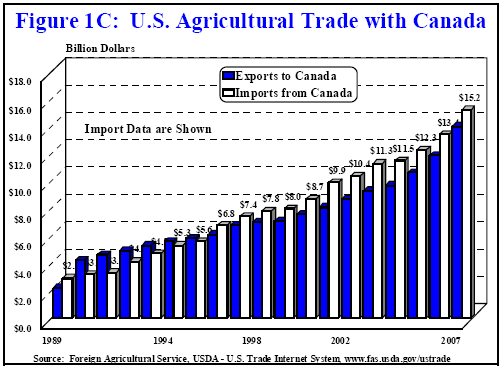AG-ECO NEWS
Vol. 24, Issue 7, March 18, 2008 – PDF version
Jose G. Peña
Texas AgriLife Extension Economist-Management
Record Ag Exports Forecast For 2008;
Weak Dollar Fueling Exports But Increased Export Dependence Will Keep U.S. Markets Volatile;
NAFTA Fully Implemented
USDA-ERS, February 21, 2008, Outlook for U.S. Agricultural Trade report, forecast U.S. agricultural exports for 2008 at a record $101.0 billion, up $10 billion from the preliminary estimate in Nov. ‘07 and $19.1 billion higher than 2007. This is the highest increase in exports on record. While about two-thirds of this Ag export growth is due to higher prices, one-third due to increased tonnage. A substantial amount of these increased exports are going to economically expanding countries in Asia, such as China and India with about ten and eight percent growth, respectively. These Asian countries are fueling demand and U.S. Ag products are in good position to provide competitively priced goods.
Agricultural imports into the U.S. for fiscal 2008 are also forecast at a record $76.5 billion, up one billion from November and $6.5 billion above 2007. Grains and feeds, grain products, and oilseeds and products account for 37 percent of the overall increase, mainly the result of higher prices.
The Ag trade surplus forecast of $24.5 billion is up 58 percent from the initial Nov. ‘07 forecast of $15.5 billion and more than double 2007’s surplus of 11.9 billion. (See Figure 1). Weak Dollar
Weak Dollar
A weak dollar, which dropped to record lows against the euro last week, is partially fueling this huge Ag export increase, along with higher commodity prices and greater export volumes. However, the U.S. over-all trade deficit widened slightly in January as strong American exports were more than offset by higher prices for imported oil. Price bids for crude oil soared to a record high $108/barrel last week. But, while the U.S. overall trade deficit widened slightly in December and January, the broader trend has been in the other directions as exports continue to increase. Some contend that increased exports is one of the few economic factors fueling the U.S. economy.
The weak dollar is having a major impact on the commodities market. Futures price bids have risen an average of $20 in less than two months, largely on the weakness of the U.S. dollar. When the dollar weakens, commodities priced in dollars effectively become cheaper for buyers holding other currencies. This increases demand. Futures price bids for most commodities are responding to this increased demand, way beyond the typical response to basic supply/demand fundamentals. For example, futures price bids for Dec. ‘08 cotton contracts in the New York Cotton Exchange traded as high as 98.9 cents a pound in late Dec. ‘07, see-sawed up the limit one day, down the limit the next day and are now trading in the mid-80’s. This uncertainty and increased dependence on export markets will keep U.S. markets volatile.
NAFTA
Meanwhile, with the last remaining trade restrictions on a handful of agricultural commodities now removed, such as U.S. exports to Mexico of corn, dry edible beans, nonfat dry milk and high fructose corn syrup and Mexican exports to the U.S. of sugar and certain horticultural products, the North American Free Trade Agreement (NAFTA) was fully implemented on January 1, 2008. Ag trade between the U.S., Mexico and Canada has increased over 300 percent since the early ‘90’s as a 15-year transition period to eliminate numerous barriers to regional agricultural trade came to an end. (See Figure 1a). According to USDA’s-FAS January 2008 Fact Sheet of NAFTA, in 2007, Canada and Mexico were, respectively, the first and second largest export markets for U.S. agricultural products. Exports to the two markets combined were greater than exports to the next six largest markets combined. U.S. agricultural exports to Mexico have almost tripled to about $12.7 billion in 2007 since NAFTA was implemented in 1994. (Figure 1b). And, while exports to Canada have also nearly tripled, reaching $14.0 billion in 2007, up from $4.2 billion in 1990, imports from Canada have grown even more, from $3.2 billion to $15.2 billion. (Figure 1c). Fresh and processed fruits and vegetables, snack foods, and other consumer foods account for close to three-fourths of U.S. sales to Canada.
According to USDA’s-FAS January 2008 Fact Sheet of NAFTA, in 2007, Canada and Mexico were, respectively, the first and second largest export markets for U.S. agricultural products. Exports to the two markets combined were greater than exports to the next six largest markets combined. U.S. agricultural exports to Mexico have almost tripled to about $12.7 billion in 2007 since NAFTA was implemented in 1994. (Figure 1b). And, while exports to Canada have also nearly tripled, reaching $14.0 billion in 2007, up from $4.2 billion in 1990, imports from Canada have grown even more, from $3.2 billion to $15.2 billion. (Figure 1c). Fresh and processed fruits and vegetables, snack foods, and other consumer foods account for close to three-fourths of U.S. sales to Canada.


